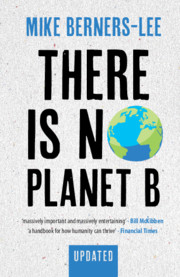Book contents
- There Is No Planet B
- Reviews
- There Is No Planet B
- Copyright page
- Additional material
- Dedication
- Contents
- Acknowledgements
- What’s New in this Updated Edition?
- Introduction to the First Edition
- 1 Food
- 2 More on Climate and Environment
- 3 Energy
- 4 Travel and Transport
- 5 Growth, Money and Metrics
- 6 People and Work
- 7 Business and Technology
- 8 Values, Truth and Trust
- 9 Thinking Skills for Today’s World
- 10 Protest
- 11 Big-Picture Summary
- 12 What Can I Do?
- Appendix: Climate Emergency Basics
- Alphabetical Quick Tour
- Notes on Units
- EndNotes
- Index
Introduction to the First Edition
Published online by Cambridge University Press: 07 January 2021
- There Is No Planet B
- Reviews
- There Is No Planet B
- Copyright page
- Additional material
- Dedication
- Contents
- Acknowledgements
- What’s New in this Updated Edition?
- Introduction to the First Edition
- 1 Food
- 2 More on Climate and Environment
- 3 Energy
- 4 Travel and Transport
- 5 Growth, Money and Metrics
- 6 People and Work
- 7 Business and Technology
- 8 Values, Truth and Trust
- 9 Thinking Skills for Today’s World
- 10 Protest
- 11 Big-Picture Summary
- 12 What Can I Do?
- Appendix: Climate Emergency Basics
- Alphabetical Quick Tour
- Notes on Units
- EndNotes
- Index
Summary
Almost every year since records began, our species has had more energy at its disposal than it had the year before. For the past 50 years, the growth rate has averaged 2.4% per year, more than tripling in total over that time. For the century before that it was more like 1% per year, and as we go back through history, the growth rate looks lower still but nevertheless positive, give or take the odd blip. We have been getting continually more powerful, not just by growing our energy supply, but by using it with ever more efficiency and inventiveness. In doing so, we have been increasingly affecting our world, through a mixture of accident and design. The restorative powers of our planet, meanwhile, have remained broadly the same, so the balance of power has been shifting – and it has now tipped. Throughout history, the dominant cultures have treated the planet as a big and robust place, compared to everything we could throw at it – and that approach has not, generally speaking, come back to bite us.
Information
- Type
- Chapter
- Information
- There Is No Planet BA Handbook for the Make or Break Years – Updated Edition, pp. 1 - 11Publisher: Cambridge University PressPrint publication year: 2021
